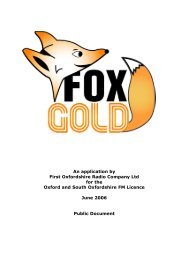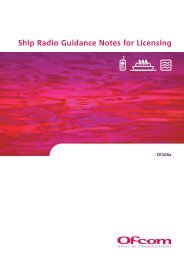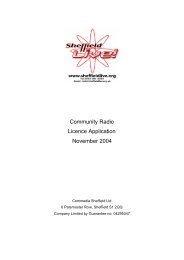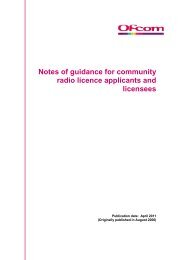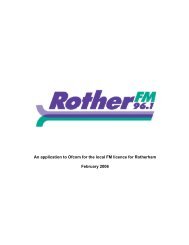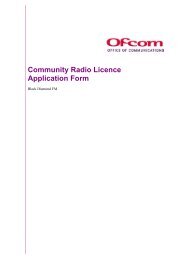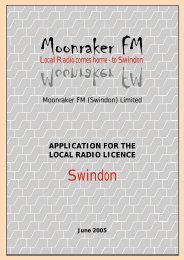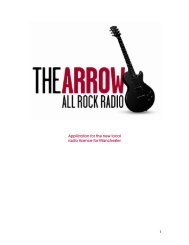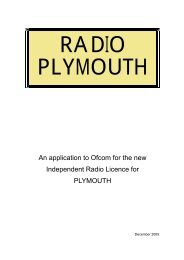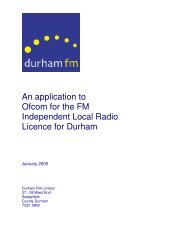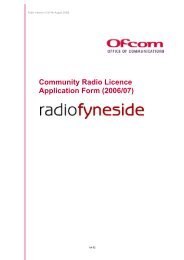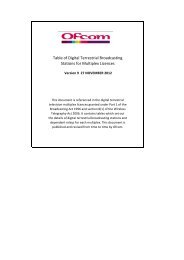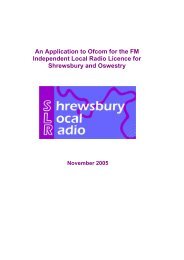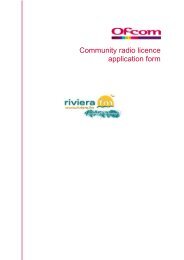Aeronautical Wireless Telegraphy Act Radio ... - Ofcom Licensing
Aeronautical Wireless Telegraphy Act Radio ... - Ofcom Licensing
Aeronautical Wireless Telegraphy Act Radio ... - Ofcom Licensing
Create successful ePaper yourself
Turn your PDF publications into a flip-book with our unique Google optimized e-Paper software.
<strong>Aeronautical</strong> <strong>Wireless</strong> <strong>Telegraphy</strong> <strong>Act</strong> <strong>Radio</strong> Licences (Including Technical Frequency Assignment)<br />
<strong>Aeronautical</strong> <strong>Wireless</strong> <strong>Telegraphy</strong> <strong>Act</strong><br />
<strong>Radio</strong> Licences<br />
Revised October 2004<br />
- 1 -
<strong>Aeronautical</strong> <strong>Wireless</strong> <strong>Telegraphy</strong> <strong>Act</strong> <strong>Radio</strong> Licences (Including Technical Frequency Assignment)<br />
1. Introduction<br />
This information sheet outlines the regulations governing the civil use of aeronautical<br />
radio equipment in the United Kingdom. These regulations require that:<br />
• radio equipment intended for use on aircraft is approved by the Civil Aviation<br />
Authority's Safety Regulation Group (SRG);<br />
• installations of radio equipment on registered aircraft, and radio equipment<br />
used on the ground for communications and navigation, are approved by<br />
SRG;<br />
• the installation and use of the radio equipment are covered by a <strong>Wireless</strong><br />
<strong>Telegraphy</strong> <strong>Act</strong> (WT <strong>Act</strong>) radio licence; and<br />
• the user of the equipment holds the correct operator's licence, issued by<br />
SRG. In the case of aircraft, the user must hold a Flight <strong>Radio</strong> Telephony<br />
Operator's licence (except glider pilots operating only on the nominated<br />
glider frequencies, and persons being trained as flight crew in a<br />
UK-registered aircraft).<br />
Details of these regulations can be found in the appropriate sections of this<br />
information sheet. A list of contacts is provided in Section 16.<br />
This information sheet also provides information on the technical frequency<br />
assignment criteria used for <strong>Aeronautical</strong> Ground Station licences.<br />
- 2 -
<strong>Aeronautical</strong> <strong>Wireless</strong> <strong>Telegraphy</strong> <strong>Act</strong> <strong>Radio</strong> Licences (Including Technical Frequency Assignment)<br />
2. The Office of Communications<br />
The Office of Communications (<strong>Ofcom</strong>) is responsible for managing that part of the<br />
radio spectrum used for civil purposes in the UK.<br />
- 3 -
<strong>Aeronautical</strong> <strong>Wireless</strong> <strong>Telegraphy</strong> <strong>Act</strong> <strong>Radio</strong> Licences (Including Technical Frequency Assignment)<br />
3. The Civil Aviation Authority<br />
The Civil Aviation Authority (CAA) is a public corporation, charged by the<br />
Government with regulating all aspects of aviation in the UK. It is split into four<br />
directorates, two of which have a direct role in regulating aeronautical radio:<br />
• The Directorate of Airspace Policy (DAP) is responsible for the regulation<br />
and planning of airspace in the UK, for the benefit of all users – military,<br />
commercial and civil business. By agreement with <strong>Ofcom</strong>, DAP manages the<br />
aeronautical radio spectrum in the UK, recognising that there is a direct link<br />
with the management of the airspace. <strong>Ofcom</strong> has also contracted DAP to<br />
administer WT <strong>Act</strong> radio licences for aircraft, aeronautical ground stations and<br />
navigation aids.<br />
• The Safety Regulation Group (SRG) ensures high standards of safety for<br />
civil aviation in the UK. To ensure the safe use of aeronautical radio, it<br />
approves the installation and use of aeronautical ground stations and<br />
navigational aids, and the carriage of aeronautical radio equipment in aircraft;<br />
it also issues certificates of competence to operators.<br />
- 4 -
<strong>Aeronautical</strong> <strong>Wireless</strong> <strong>Telegraphy</strong> <strong>Act</strong> <strong>Radio</strong> Licences (Including Technical Frequency Assignment)<br />
4. Managing the radio spectrum<br />
The radio spectrum is a scarce natural resource with finite capacity, for which<br />
demand is constantly increasing. Used by millions of people worldwide for a variety<br />
of purposes, radio signals do not stop at national frontiers or man-made borders.<br />
Without adequate planning and management, radio signals from different users and<br />
services would interfere with each other; above a certain level of interference, radio<br />
would become useless as a suitable means of communication.<br />
- 5 -
<strong>Aeronautical</strong> <strong>Wireless</strong> <strong>Telegraphy</strong> <strong>Act</strong> <strong>Radio</strong> Licences (Including Technical Frequency Assignment)<br />
5. Spectrum planning<br />
<strong>Ofcom</strong> (supported by DAP) plays a key role in many international negotiations,<br />
planning and co-ordinating the use of spectrum with neighbouring countries while<br />
protecting and promoting the UK's interests.<br />
<strong>Aeronautical</strong> frequency bands are internationally agreed and set out in the <strong>Radio</strong><br />
Regulations, which are agreed at World <strong>Radio</strong> Conferences of the International<br />
Telecommunication Union (ITU) – a specialised agency of the United Nations. The<br />
<strong>Radio</strong> Regulations have international treaty status and are binding on ITU member<br />
states, including the UK.<br />
Because of international competition between expanding radio services, existing<br />
radio users must continually defend and justify the retention of frequency bands<br />
already allocated to their service. Civil air operations are expanding rapidly and<br />
globally, creating additional pressures on the already stressed and limited resource.<br />
- 6 -
<strong>Aeronautical</strong> <strong>Wireless</strong> <strong>Telegraphy</strong> <strong>Act</strong> <strong>Radio</strong> Licences (Including Technical Frequency Assignment)<br />
6. Regulation and licensing<br />
To ensure that everyone obtains the required service from its use, the radio spectrum<br />
must be regulated. This is achieved by:<br />
• controlling the use of radio, e.g. by educating radio users and issuing<br />
operators' qualifications;<br />
• ensuring that radio equipment can be used safely in its intended environment<br />
without causing interference to other systems and users;<br />
• developing technical specifications for the performance of equipment; and<br />
• issuing licences to users of equipment where there is the potential for<br />
interference, to ensure that they comply with the above requirements.<br />
- 7 -
<strong>Aeronautical</strong> <strong>Wireless</strong> <strong>Telegraphy</strong> <strong>Act</strong> <strong>Radio</strong> Licences (Including Technical Frequency Assignment)<br />
7. <strong>Wireless</strong> <strong>Telegraphy</strong> <strong>Act</strong> radio<br />
licensing<br />
<strong>Ofcom</strong>’s powers are set out in the <strong>Wireless</strong> <strong>Telegraphy</strong> <strong>Act</strong> 2006, that provides for radio<br />
licensing. Under the WT <strong>Act</strong>, it is an offence to install or use radio transmission<br />
equipment without a licence, unless it is specifically licence-exempt.<br />
- 8 -
<strong>Aeronautical</strong> <strong>Wireless</strong> <strong>Telegraphy</strong> <strong>Act</strong> <strong>Radio</strong> Licences (Including Technical Frequency Assignment)<br />
8. The importance of licensing<br />
Abuse of the radio spectrum is an obvious hazard to the safety of life, as well as to<br />
commercial activities. <strong>Aeronautical</strong> services are recognised internationally as prime<br />
users of radio frequencies. Without radio, aircraft operations would be unsafe and<br />
unable to meet the global demand for rapid and cost-effective transport.<br />
It is important to comply with the terms of a radio licence, as this reduces the<br />
likelihood of causing interference to other radio users.<br />
Because of radio spectrum congestion, all users have a duty to ensure that their<br />
operations use the radio spectrum efficiently.<br />
- 9 -
<strong>Aeronautical</strong> <strong>Wireless</strong> <strong>Telegraphy</strong> <strong>Act</strong> <strong>Radio</strong> Licences (Including Technical Frequency Assignment)<br />
9. Control of interference and<br />
enforcement<br />
<strong>Ofcom</strong> has offices across the UK, through which we advise customers on radio<br />
services and investigate complaints of interference. Where necessary, we will not<br />
hesitate to prosecute or take other necessary enforcement action under the WT <strong>Act</strong>,<br />
to prevent interference caused by those who operate without a licence or contravene<br />
their licence conditions.<br />
<strong>Ofcom</strong> staff carry out routine spot checks to ensure that users of aeronautical<br />
equipment hold valid licences.<br />
- 10 -
<strong>Aeronautical</strong> <strong>Wireless</strong> <strong>Telegraphy</strong> <strong>Act</strong> <strong>Radio</strong> Licences (Including Technical Frequency Assignment)<br />
10. <strong>Radio</strong> licences for aircraft<br />
Aircraft radio licences are available in three forms:<br />
• an Aircraft licence to cover the use of aeronautical radio equipment in a UKregistered<br />
aircraft;<br />
• an Aircraft licence to cover unregistered aircraft not intended to fly outside<br />
the UK; and<br />
• an Aircraft Transportable licence to cover the use of a handheld VHF radio<br />
with an integral antenna and power supply on multiple aircraft.<br />
To apply for an Aircraft licence, you should obtain and complete Form ACT1 and<br />
return it to DAP's <strong>Radio</strong> <strong>Licensing</strong> Section with the appropriate licence fee (see<br />
Section 16).<br />
If you want a licence for a registered aircraft, DAP staff will obtain details of the<br />
aircraft's equipment fit from the SRG's Applications and Certification Section, and<br />
your licence will include the CAA's certificate of approval of radio installation<br />
(previously issued as the AD917 document). You should ensure that SRG has<br />
approved the equipment fitted in your aircraft, and should inform your maintenance<br />
organisation or SRG's Application and Certification Section of any changes to the<br />
equipment. The fee for this type of licence depends on the take-off weight of the<br />
aircraft; for larger aircraft, there is a choice between the standard 12-month licence<br />
and a monthly licence to facilitate delivery of aircraft etc.<br />
If your aircraft is unregistered or you are applying for a Transportable licence, you<br />
must supply details of the radio equipment to be used. This will be checked against<br />
the CAA's list of approved equipment before a licence is issued.<br />
- 11 -
<strong>Aeronautical</strong> <strong>Wireless</strong> <strong>Telegraphy</strong> <strong>Act</strong> <strong>Radio</strong> Licences (Including Technical Frequency Assignment)<br />
11. Licences for aeronautical ground<br />
stations<br />
<strong>Aeronautical</strong> Ground Station (AGS) licences cover the use of aeronautical radio<br />
frequencies for ground-to-air communications.<br />
If you want to establish a new aeronautical ground radio station you must obtain both<br />
a WT <strong>Act</strong> <strong>Radio</strong> Licence and an Approval issued by SRG under Article 104 of the Air<br />
Navigation Order. You should obtain and complete CAA form SRG 1417 Application<br />
to Establish or Change an <strong>Aeronautical</strong> Ground Station.<br />
Once DAP’s <strong>Radio</strong> <strong>Licensing</strong> Section have received your completed form a copy will<br />
be passed to SRG’s Air Traffic Safety Standards Department who will process the<br />
ANO Approval. <strong>Radio</strong> <strong>Licensing</strong> Staff will arrange for a frequency to be assigned<br />
(where necessary) before issuing your licence. Technical frequency assignment<br />
criteria are used when frequencies are assigned - these are specified in a little more<br />
detail in Section 11.1 below.<br />
The AGS licence is required for any testing of the radio station that the ATSSD has<br />
authorised. For operational use, it must be accompanied by a valid ANO approval.<br />
Short-term AGS licences are available to cover special events, and must be applied<br />
for in the same way.<br />
There are seven forms of AGS licence.<br />
1 The AGS General Aviation licence covers:<br />
• Common air to ground frequencies which have been assigned to general<br />
aviator sporting use such as the common glider frequency.<br />
2. The AGS Fire licence covers:<br />
• <strong>Aeronautical</strong> fire station assignments on the frequency 121.600 MHz.<br />
3. The AGS Air to Ground and Flight Information Service licence covers:<br />
• Air/Ground (A/G) – A two way communication between an aircraft and a<br />
ground station in which the ground operator may only pass advisory<br />
information regarding the situation local to the aerodrome.<br />
• Aerodrome Flight Information Service (AFIS) – A two way communication<br />
between an aircraft and a ground station, in which the ground operator may<br />
only pass advisory information regarding the airborne situation local to the<br />
aerodrome but can pass instructions to the aircraft on the ground at the<br />
aerodrome.<br />
4. The AGS Air Traffic Control/Ground Movement Control licence covers:<br />
- 12 -
<strong>Aeronautical</strong> <strong>Wireless</strong> <strong>Telegraphy</strong> <strong>Act</strong> <strong>Radio</strong> Licences (Including Technical Frequency Assignment)<br />
• Area Control Centre Service (ACC) – A two way communication between<br />
an aircraft and a ground station in which the ground operator provides<br />
control instructions to the aircraft within a defined region or sector.<br />
• Approach (APP) – a two-way communication between an aircraft and a<br />
ground station, in which the ground operator controls the aircraft in the<br />
vicinity of an aerodrome traffic zone when the aircraft is not flying by<br />
visual reference to the aerodrome<br />
• Automatic Terminal Information Service (ATIS) – A broadcast<br />
transmission from a ground station to one or more aircraft, conveying<br />
information relating to the aerodrome from which the transmission made is<br />
conveyed. Within the UK this service is regarded as an air traffic control<br />
service and may be provided by an aerodrome that also provides a tower<br />
and/or an approach service.<br />
• Aerodrome Surface (AS) – Either a two-way communication between an<br />
aircraft and a ground station in which the ground operator provides either<br />
control to or information for an aircraft on the ground category includes<br />
Ground Movement Control (GMC) & Fire. Or: An automated broadcast<br />
service passing aerodrome information from a ground station to an aircraft<br />
on the ground at that aerodrome. This category covers departure ATIS<br />
(DATIS).<br />
• Flight Information Service (F or FIS) – A two-way communication between<br />
an aircraft and a ground station, in which the ground operator may only<br />
pass advisory information as requested by the pilot. This information may<br />
include situation awareness and weather information.<br />
• Precision Approach Radar (PR or PAR) –A two-way communication<br />
between an aircraft and a ground station, in which the ground operator<br />
uses both vertical and horizontal information about an aircraft's position to<br />
talk the aircraft down along the glide scope.<br />
• Volmet – A broadcast transmission from a ground station to one or more<br />
aircraft, in which meteorological information relating to a number of<br />
aerodromes as defined in the UK AIP. Within the UK, this service is<br />
regarded as an air traffic control service.<br />
• Tower (TWR) – A two-way communication between an aircraft and a<br />
groundstation, in which the ground operator controls the aircraft in the<br />
vicinity of an aerodrome traffic zone when the aircraft is flying with visual<br />
reference to the aerodrome.<br />
5. The AGS Operations Control licence covers:<br />
Operational Control (OPC) – A two-way communication between an aircraft and a<br />
ground station for the purposes stated in ICAO Annex 6, Parts 1 & 3, chapter 1:<br />
"Operational Control. The exercise of authority over the initiation, continuation,<br />
diversion or termination of a flight in the interest of safety of the aircraft and the<br />
regularity and efficiency of the flight."<br />
- 13 -
<strong>Aeronautical</strong> <strong>Wireless</strong> <strong>Telegraphy</strong> <strong>Act</strong> <strong>Radio</strong> Licences (Including Technical Frequency Assignment)<br />
OPC services are currently provided by either voice communications or a slow-speed<br />
data communication known as ACARS.<br />
6. The AGS Offshore Platform licence covers:<br />
Offshore platforms operating in UK territorial waters that are assigned a Traffic<br />
Frequency (A/G) and/or a logistics frequency (OPC), or, a single frequency to be<br />
used for both traffic and logistic services. The licence also covers mobile platforms<br />
where the <strong>Radio</strong> Frequency allocation is carried out using an area system based on<br />
block on sub blocks. Details of this are published in the UK AIP (CAP 32)<br />
7. The AGS HF licence covers:<br />
<strong>Aeronautical</strong> ground station where an HF assignment is required.<br />
11.1 Technical frequency assignment criteria applied to AGS<br />
Technical frequency assignment criteria describe the technical principles and<br />
guidelines used to identify which particular radio frequency or radio frequency<br />
channel(s), from the bands specified for the relevant licence type, are available for<br />
authorisation at any particular location and under what technical conditions.<br />
Technical frequency assignment criteria may limit (or prevent) the availability of a<br />
licence, and/or grants of rights under a licence, at a particular location if this is<br />
necessary to prevent interference to existing services.<br />
DAP has been delegated responsibility for managing the part of the radio spectrum<br />
allocated for aeronautical purposes. DAP’s procedure for the management and<br />
allocation of radio frequency is contained in Annex M of DAP’s Airspace Charter<br />
which is available from the CAA website www.caa.co.uk.<br />
- 14 -
<strong>Aeronautical</strong> <strong>Wireless</strong> <strong>Telegraphy</strong> <strong>Act</strong> <strong>Radio</strong> Licences (Including Technical Frequency Assignment)<br />
12. Licences for aeronautical<br />
navigation aids<br />
The <strong>Aeronautical</strong> Navigation Aid radio licence covers the following main types of<br />
navigation aid:<br />
• The non-directional radio beacon (NDB) service is used for short/mediumrange<br />
navigation. When used with automatic direction finder (ADF) equipment<br />
in aircraft, NDB provides a bearing with moderate accuracy. NDB is used by<br />
larger aircraft over sea or overland routes and is extensively deployed at<br />
general aviation aerodromes, where it provides a cost-effective and easily<br />
installed facility.<br />
• The instrument landing system (ILS) is one of the International Civil<br />
Aviation Organization's (ICAO) standard approach and landing systems. The<br />
ILS localizer is coupled with glide path frequencies and with the Microwave<br />
landing system (MLS) and/or DME (see below). MLS is a newer system,<br />
which operates in a similar manner to ILS.<br />
• The VHF omnidirectional radio range (VOR) is a short/medium-range<br />
navigation aid. VOR is normally associated with DME.<br />
• The distance measuring system (DME) is the ICAO standard system for<br />
determining ranges within radio line of sight, using pulse techniques and time<br />
measurement. It is the standard system used for en route and terminal<br />
navigation.<br />
<strong>Aeronautical</strong> Radar Licence<br />
• A licence is available to cover <strong>Aeronautical</strong> Primary radar and Secondary<br />
surveillance radar (SSR) is an ICAO standard system employing secondary<br />
radar principles, used either by itself or co-located and synchronised with<br />
primary radar. All SSR installations have a frequency for ground-air<br />
interrogation and a frequency for the air-ground reply.<br />
- 15 -
<strong>Aeronautical</strong> <strong>Wireless</strong> <strong>Telegraphy</strong> <strong>Act</strong> <strong>Radio</strong> Licences (Including Technical Frequency Assignment)<br />
13. Licence fees<br />
Licence fees are collected to contribute to the costs of managing the radio spectrum.<br />
<strong>Ofcom</strong> is required to cover its costs in full; this is achieved by charging fees for the<br />
issue of licences, and by recovering costs from other Government departments and<br />
major users of radio spectrum.<br />
DAP collects aeronautical radio licence fees on behalf of <strong>Ofcom</strong>. Licence fees are<br />
reviewed each year, and their level is set by an order of parliament. Licence fees are<br />
payable annually for 12-month licences; once a licence has been issued, the fee<br />
cannot be refunded.<br />
- 16 -
<strong>Aeronautical</strong> <strong>Wireless</strong> <strong>Telegraphy</strong> <strong>Act</strong> <strong>Radio</strong> Licences (Including Technical Frequency Assignment)<br />
14. Renewing your licence<br />
With the exception of short-term Aircraft and AGS licences, all licences are valid for<br />
12 months and must be renewed to stay in force. DAP will automatically issue a<br />
renewal reminder approximately six weeks before the licence renewal date. Once the<br />
licence is renewed, a new licence document will be issued. If DAP receives no<br />
response to the renewal reminder, a further reminder will be issued approximately<br />
one week before the renewal date.<br />
- 17 -
<strong>Aeronautical</strong> <strong>Wireless</strong> <strong>Telegraphy</strong> <strong>Act</strong> <strong>Radio</strong> Licences (Including Technical Frequency Assignment)<br />
15. Amending your licence<br />
If you have an Aircraft licence for a UK-registered aircraft and your address changes,<br />
contact the CAA Aircraft Registrations Department, which will automatically ask<br />
DAP's <strong>Radio</strong> <strong>Licensing</strong> Section to issue an amended licence.<br />
If you change the radio equipment in your registered aircraft, contact the aircraft's<br />
maintenance provider or your local CAA office. DAP's <strong>Radio</strong> <strong>Licensing</strong> Section will be<br />
notified of the change once it has been approved, and will issue an amended Aircraft<br />
licence.<br />
Changes to the licensing information for unregistered aircraft should be sent in<br />
writing to DAP's <strong>Radio</strong> <strong>Licensing</strong> Section.<br />
If the details on your AGS or <strong>Aeronautical</strong> Navigation Aid licence change, you should<br />
obtain and complete CAA form SRG 1417 “Application to Establish or Change an<br />
<strong>Aeronautical</strong> Ground Station” and return it to <strong>Radio</strong> <strong>Licensing</strong>. <strong>Radio</strong> <strong>Licensing</strong> will<br />
liase with ATSSD to update and reissue the ANO Approval and <strong>Radio</strong> licence.<br />
- 18 -
<strong>Aeronautical</strong> <strong>Wireless</strong> <strong>Telegraphy</strong> <strong>Act</strong> <strong>Radio</strong> Licences (Including Technical Frequency Assignment)<br />
16. Further information<br />
To obtain an aeronautical radio licence application form, or for information on the<br />
processing of a licence, contact DAP's <strong>Radio</strong> <strong>Licensing</strong> Section:<br />
<strong>Radio</strong> <strong>Licensing</strong> Section<br />
Directorate of Airspace Policy<br />
CAA House, K6 G6<br />
45-59 Kingsway<br />
London<br />
WC2B 6TE<br />
Tel: 020 7453 6555<br />
Fax: 020 7453 6556<br />
Email: radio.licensing@dap.caa.co.uk<br />
Information and application forms can also be obtained via the CAA website,<br />
www.caa.co.uk -select Airspace from the main menu and then <strong>Radio</strong> <strong>Licensing</strong>.<br />
For queries relating to WT <strong>Act</strong> licensing policy, contact <strong>Ofcom</strong>’s Maritime and<br />
<strong>Aeronautical</strong> Team on 020 981 3132/3087.<br />
<strong>Ofcom</strong> produces information sheets and publications on most aspects of its work.<br />
They are available from the <strong>Ofcom</strong> contact centre on 0845 456 3000, or can be<br />
downloaded from <strong>Ofcom</strong>’s website at www.ofcom.org.uk<br />
The CAA's Safety Regulation Group can be contacted at:<br />
Safety Regulation Group<br />
Aviation House<br />
Gatwick Airport South<br />
West Sussex<br />
RH6 0YR<br />
Tel: 01293 567171<br />
For general enquiries about operators' licences, including the location of authorized<br />
radiotelephony examiners, call the CAA's Flight Crew <strong>Licensing</strong> Department on<br />
01293 573700.<br />
For enquiries about approval of aeronautical radio equipment on aircraft, call the<br />
CAA's Avionics Systems Section on 01293 573935.<br />
For enquiries about approval of aeronautical radio equipment installations on<br />
registered aircraft, call the CAA's Applications and Certification Section on<br />
01293 768374.<br />
For enquiries about setting up or taking over an aeronautical ground station or a<br />
navigation aid, contact <strong>Radio</strong> <strong>Licensing</strong>.<br />
- 19 -
<strong>Aeronautical</strong> <strong>Wireless</strong> <strong>Telegraphy</strong> <strong>Act</strong> <strong>Radio</strong> Licences (Including Technical Frequency Assignment)<br />
CAA publications can be obtained from:<br />
Documedia Ltd<br />
37 Windsor Street<br />
Cheltenham<br />
Gloucestershire<br />
GL52 2DG<br />
Tel: 01242 283100<br />
Fax: 01242 584139<br />
Previously <strong>Radio</strong>communications Agency Information Sheet RA 417<br />
June 2004<br />
- 20 -



